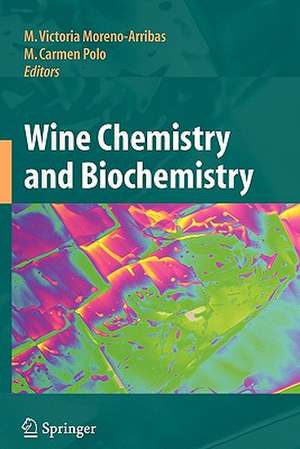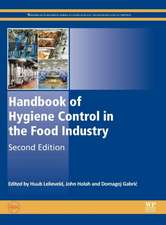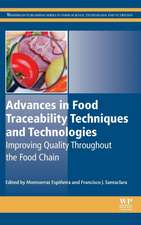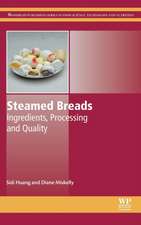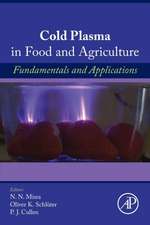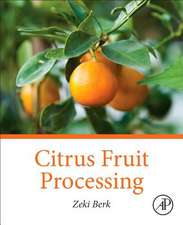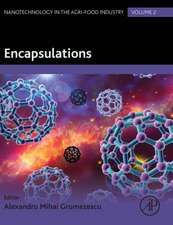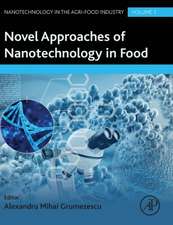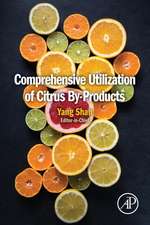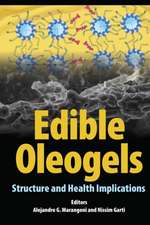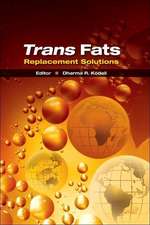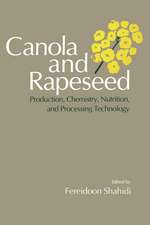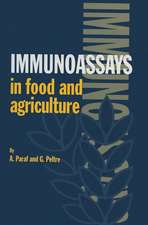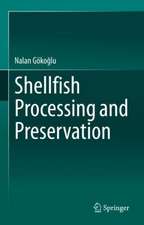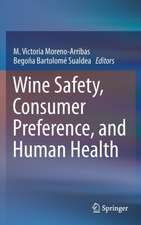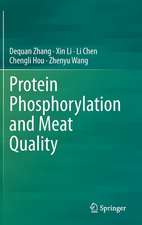Wine Chemistry and Biochemistry
Editat de M. Victoria Moreno-Arribas, Carmen Poloen Limba Engleză Paperback – 29 oct 2010
The first part of the book summarizes the most important aspects of winemaking technology and microbiology. The second most extensive part deals with the different groups of compounds, how these are modified during the various steps of the production process, and how they affect the wine quality, sensorial aspects, and physiological activity, etc. The third section describes undesirable alterations of wines, including those affecting quality and food safety. Finally, the treatment of data will be considered, an aspect which has not yet been tackled in any other book on enology. In this chapter, the authors not only explain the tools available for analytical data processing, but also indicate the most appropriate treatment to apply, depending on the information required, illustrating with examples throughout the chapter from enological literature.
| Toate formatele și edițiile | Preț | Express |
|---|---|---|
| Paperback (1) | 1677.38 lei 6-8 săpt. | |
| Springer – 29 oct 2010 | 1677.38 lei 6-8 săpt. | |
| Hardback (1) | 1731.50 lei 6-8 săpt. | |
| Springer – 14 noi 2008 | 1731.50 lei 6-8 săpt. |
Preț: 1677.38 lei
Preț vechi: 2045.58 lei
-18% Nou
Puncte Express: 2516
Preț estimativ în valută:
320.96€ • 335.11$ • 265.64£
320.96€ • 335.11$ • 265.64£
Carte tipărită la comandă
Livrare economică 05-19 aprilie
Preluare comenzi: 021 569.72.76
Specificații
ISBN-13: 9781441925480
ISBN-10: 1441925481
Pagini: 752
Ilustrații: XV, 735 p.
Dimensiuni: 155 x 235 x 39 mm
Greutate: 1.13 kg
Ediția:Softcover reprint of hardcover 1st ed. 2009
Editura: Springer
Colecția Springer
Locul publicării:New York, NY, United States
ISBN-10: 1441925481
Pagini: 752
Ilustrații: XV, 735 p.
Dimensiuni: 155 x 235 x 39 mm
Greutate: 1.13 kg
Ediția:Softcover reprint of hardcover 1st ed. 2009
Editura: Springer
Colecția Springer
Locul publicării:New York, NY, United States
Public țintă
ResearchDescriere
The aim of this book is to describe chemical and biochemical aspects of winemaking that are currently being researched. The authors have selected the very best experts for each of the areas.
The first part of the book summarizes the most important aspects of winemaking technology and microbiology. The second most extensive part deals with the different groups of compounds, how these are modified during the various steps of the production process, and how they affect the wine quality, sensorial aspects, and physiological activity, etc. The third section describes undesirable alterations of wines, including those affecting quality and food safety. Finally, the treatment of data will be considered, an aspect which has not yet been tackled in any other book on enology. In this chapter, the authors not only explain the tools available for analytical data processing, but also indicate the most appropriate treatment to apply, depending on the information required, illustrating with examples throughout the chapter from enological literature.
The first part of the book summarizes the most important aspects of winemaking technology and microbiology. The second most extensive part deals with the different groups of compounds, how these are modified during the various steps of the production process, and how they affect the wine quality, sensorial aspects, and physiological activity, etc. The third section describes undesirable alterations of wines, including those affecting quality and food safety. Finally, the treatment of data will be considered, an aspect which has not yet been tackled in any other book on enology. In this chapter, the authors not only explain the tools available for analytical data processing, but also indicate the most appropriate treatment to apply, depending on the information required, illustrating with examples throughout the chapter from enological literature.
Cuprins
Chemical and Biochemical Aspects ofWinemaking.- Biochemistry of Alcoholic Fermentation.- Biochemical Transformations Produced by Malolactic Fermentation.- Special Wines Production.- SparklingWines and Yeast Autolysis.- Biologically Aged Wines.- Enzymes in Winemaking.- Use of Enological Additives for Colloid and Tartrate Salt Stabilization in White Wines and for Improvement of Sparkling Wine Foaming Properties.- Wine Chemical Compounds and Biochemical Processes.- Nitrogen Compounds.- Amino Acids and Biogenic Amines.- Peptides.- Proteins.- Carbohydrates.- Volatile and Aroma Compounds.- Wine Aroma Precursors.- Polyfunctional Thiol Compounds.- Volatile Compounds and Wine Aging.- Yeasts and Wine Flavour.- Identification of Impact Odorants of Wines.- Interactions Between Wine Matrix Macro-Components and Aroma Compounds.- Phenolic Compounds.- Anthocyanins and Anthocyanin-Derived Compounds.- Flavanols, Flavonols and Dihydroflavonols.- Non-flavonoid Phenolic Compounds.- Influence of Phenolics on Wine Organoleptic Properties.- Health-Promoting Effects of Wine Phenolics.- Spoilage ofWines.- Aromatic Spoilage of Wines by Raw Materials and Enological Products.- Wine Spoilage by Fungal Metabolites.- Automatic Analysers and Data Processing.- Automatic Analysers in Oenology.- Statistical Techniques for the Interpretation of Analytical Data.
Notă biografică
Carmen Polo is Research Professor at the Institute of Industrial Fermentations of the Spanish National Research Council (CSIC) at Madrid, Spain. She was the Director of the Institute from 1991 through 2002. She is member of the experts group of the Sub-Commission of Methods of Analysis from the International Organisation of Vine and Wine (OIV). She was awarded with the OIV prize for the book "El vinagre de vino". Dr. Polo is author of more than 90 research papers in peer reviewer journals and more than 20 books chapters in books of scientific editorials.
M. Victoria Moreno-Arribas is a Senior at the Institute of Industrial Fermentations of the Spanish National Research Council (CSIC) at Madrid, Spain. She is member of the Spanish Delegation as an expertise in the International Organization of Vine and Wine (OIV). She is also been appointed Professor of Enology by the Autonoma University of Madrid (UAM). She is author in over 70 SCI papers and 18 book chapters in books of scientific editorials.
M. Victoria Moreno-Arribas is a Senior at the Institute of Industrial Fermentations of the Spanish National Research Council (CSIC) at Madrid, Spain. She is member of the Spanish Delegation as an expertise in the International Organization of Vine and Wine (OIV). She is also been appointed Professor of Enology by the Autonoma University of Madrid (UAM). She is author in over 70 SCI papers and 18 book chapters in books of scientific editorials.
Textul de pe ultima copertă
The aim of this book is to describe chemical and biochemical aspects of winemaking that are currently being researched. The authors have selected the very best experts for each of the areas.
The first part of the book summarizes the most important aspects of winemaking technology and microbiology. The second most extensive part deals with the different groups of compounds, how these are modified during the various steps of the production process, and how they affect the wine quality, sensorial aspects, and physiological activity, etc. The third section describes undesirable alterations of wines, including those affecting quality and food safety. Finally, the treatment of data will be considered, an aspect which has not yet been tackled in any other book on enology. In this chapter, the authors not only explain the tools available for analytical data processing, but also indicate the most appropriate treatment to apply, depending on the information required, illustrating with examples throughout the chapter from enological literature.
The first part of the book summarizes the most important aspects of winemaking technology and microbiology. The second most extensive part deals with the different groups of compounds, how these are modified during the various steps of the production process, and how they affect the wine quality, sensorial aspects, and physiological activity, etc. The third section describes undesirable alterations of wines, including those affecting quality and food safety. Finally, the treatment of data will be considered, an aspect which has not yet been tackled in any other book on enology. In this chapter, the authors not only explain the tools available for analytical data processing, but also indicate the most appropriate treatment to apply, depending on the information required, illustrating with examples throughout the chapter from enological literature.
Caracteristici
Scientifically written including current trends but also in a style that is clear and easy to understand
Useful book for wine researchers and enologists alike, as well as for winemakers and other professionals of the sector, and students of enology, food technology, and similar disciplines
Includes supplementary material: sn.pub/extras
Useful book for wine researchers and enologists alike, as well as for winemakers and other professionals of the sector, and students of enology, food technology, and similar disciplines
Includes supplementary material: sn.pub/extras
